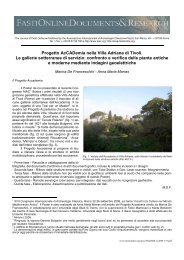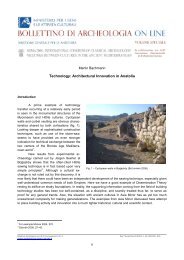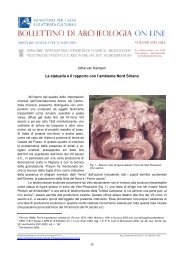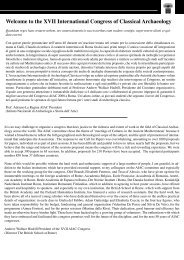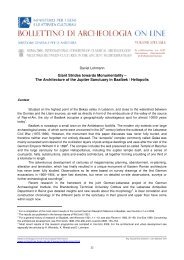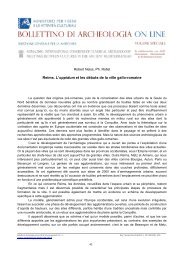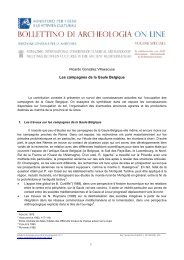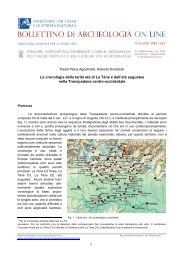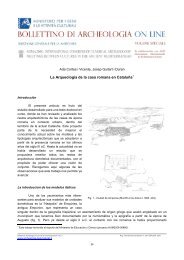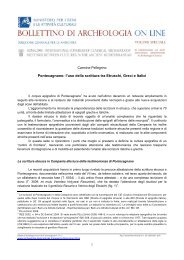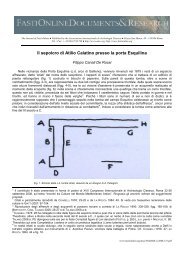Sarcophagi in Roman Britain - Bollettino di archeologia on line
Sarcophagi in Roman Britain - Bollettino di archeologia on line
Sarcophagi in Roman Britain - Bollettino di archeologia on line
Create successful ePaper yourself
Turn your PDF publications into a flip-book with our unique Google optimized e-Paper software.
B. Russell – <str<strong>on</strong>g>Sarcophagi</str<strong>on</strong>g> <str<strong>on</strong>g>in</str<strong>on</strong>g> <str<strong>on</strong>g>Roman</str<strong>on</strong>g> Brita<str<strong>on</strong>g>in</str<strong>on</strong>g>Aquitania 25 . The <str<strong>on</strong>g>in</str<strong>on</strong>g>scribed sarcophagi of York <str<strong>on</strong>g>in</str<strong>on</strong>g> particular, therefore, give a remarkable snap-shot of theupper classes of the city. Most probably date to the 3 rd century AD; those menti<strong>on</strong><str<strong>on</strong>g>in</str<strong>on</strong>g>g the col<strong>on</strong>ia ofEburacum post-date 208–211 when the city was granted this status. Indeed it is surely no accident thatthese pieces date to the period imme<str<strong>on</strong>g>di</str<strong>on</strong>g>ately follow<str<strong>on</strong>g>in</str<strong>on</strong>g>g the establishment of the col<strong>on</strong>y.The decorative schemes of these pieces also dem<strong>on</strong>strate an awareness of artistic trends outside ofBrita<str<strong>on</strong>g>in</str<strong>on</strong>g>. The sarcophagi of Julia Fortunata and Verecun<str<strong>on</strong>g>di</str<strong>on</strong>g>us Diogenes both have tabulae ansatae with peltashapedansae <strong>on</strong> their fr<strong>on</strong>t facades, similar to three identical un<str<strong>on</strong>g>in</str<strong>on</strong>g>scribed pieces also from York 26 . Rougherversi<strong>on</strong>s of these pelta-shaped ansae are found <strong>on</strong> the sarcophagi of Aurelius Superus and Aelia Severa 27 .The sarcophagus of Flavius Bellator meanwhile has a more tra<str<strong>on</strong>g>di</str<strong>on</strong>g>ti<strong>on</strong>ally shaped tabula ansata. Ansaeshaped as peltae are not uncomm<strong>on</strong> <str<strong>on</strong>g>in</str<strong>on</strong>g> Brita<str<strong>on</strong>g>in</str<strong>on</strong>g> but close parallels for this overall scheme come from theRh<str<strong>on</strong>g>in</str<strong>on</strong>g>eland, Noricum and Pann<strong>on</strong>ia 28 . C<strong>on</strong>sider<str<strong>on</strong>g>in</str<strong>on</strong>g>g the stylistic parallels between the decorated British piecesand c<strong>on</strong>t<str<strong>on</strong>g>in</str<strong>on</strong>g>ental examples, it is possible that craftsmen associated with the military were <str<strong>on</strong>g>in</str<strong>on</strong>g>volved. Certa<str<strong>on</strong>g>in</str<strong>on</strong>g>lythe sarcophagus of the family of Septimius Lupianus is of such quality that Toynbee preferred to see ‘thehand of a legi<strong>on</strong>ary artist of Me<str<strong>on</strong>g>di</str<strong>on</strong>g>terranean orig<str<strong>on</strong>g>in</str<strong>on</strong>g>’ at work, rather than a local craftsman 29 . The closestparallel to this piece is the sarcophagus of Clau<str<strong>on</strong>g>di</str<strong>on</strong>g>a Ursa from Carnuntum 30 . Members of the legio VI Victrixwere certa<str<strong>on</strong>g>in</str<strong>on</strong>g>ly drawn from this rough area: a detachment of sol<str<strong>on</strong>g>di</str<strong>on</strong>g>ers from this legi<strong>on</strong> who describethemselves as citizens of Italy and Noricum de<str<strong>on</strong>g>di</str<strong>on</strong>g>cated a shr<str<strong>on</strong>g>in</str<strong>on</strong>g>e and statuette to Mercury at Castlecary, <str<strong>on</strong>g>in</str<strong>on</strong>g>Stirl<str<strong>on</strong>g>in</str<strong>on</strong>g>gshire 31 . However, it is equally possible that local craftsmen were simply resp<strong>on</strong>d<str<strong>on</strong>g>in</str<strong>on</strong>g>g to the demands oftheir military clients. The third-century un<str<strong>on</strong>g>in</str<strong>on</strong>g>scribed sarcophagus from the M<str<strong>on</strong>g>in</str<strong>on</strong>g>ories <str<strong>on</strong>g>in</str<strong>on</strong>g> L<strong>on</strong>d<strong>on</strong>, for example,shows an awareness of fashi<strong>on</strong>s <str<strong>on</strong>g>in</str<strong>on</strong>g> Rome but is clearly, as Walker has noted, ‘a prov<str<strong>on</strong>g>in</str<strong>on</strong>g>cial <str<strong>on</strong>g>in</str<strong>on</strong>g>terpretati<strong>on</strong> ofmetropolitan <str<strong>on</strong>g>Roman</str<strong>on</strong>g> work’ 32 .It is tempt<str<strong>on</strong>g>in</str<strong>on</strong>g>g to see the elite <str<strong>on</strong>g>in</str<strong>on</strong>g><str<strong>on</strong>g>di</str<strong>on</strong>g>viduals who commissi<strong>on</strong>ed these decorated pieces as deliberatelyexploit<str<strong>on</strong>g>in</str<strong>on</strong>g>g the sarcophagus as a m<strong>on</strong>umental me<str<strong>on</strong>g>di</str<strong>on</strong>g>um, and a qu<str<strong>on</strong>g>in</str<strong>on</strong>g>tessentially Greco-<str<strong>on</strong>g>Roman</str<strong>on</strong>g> <strong>on</strong>e at that, fordem<strong>on</strong>strat<str<strong>on</strong>g>in</str<strong>on</strong>g>g their own romanitas, wealth and c<strong>on</strong>sequent status. Indeed a similar phenomen<strong>on</strong>, alsodatable to the 3 rd century AD, has been observed by Mócsy am<strong>on</strong>g the upper classes of the urban elite <str<strong>on</strong>g>in</str<strong>on</strong>g>Pann<strong>on</strong>ia and Moesia Superior 33 .The undecorated sarcophagiIs it possible, however, to draw the same c<strong>on</strong>clusi<strong>on</strong> for the hundreds of undecorated, un<str<strong>on</strong>g>in</str<strong>on</strong>g>scribed<str<strong>on</strong>g>Roman</str<strong>on</strong>g>o-British sarcophagi? Did these objects <str<strong>on</strong>g>in</str<strong>on</strong>g><str<strong>on</strong>g>di</str<strong>on</strong>g>cate a particular k<str<strong>on</strong>g>in</str<strong>on</strong>g>d of status that other modes of burial<str<strong>on</strong>g>di</str<strong>on</strong>g>d not?Walker has suggested that the undecorated sarcophagi of Brita<str<strong>on</strong>g>in</str<strong>on</strong>g> and elsewhere <str<strong>on</strong>g>in</str<strong>on</strong>g> the north-westernprov<str<strong>on</strong>g>in</str<strong>on</strong>g>ces often served ‘as a protective outer c<strong>on</strong>ta<str<strong>on</strong>g>in</str<strong>on</strong>g>er for burials and grave goods, often of high value, andnot, as <str<strong>on</strong>g>in</str<strong>on</strong>g> decorated sarcophagi of Me<str<strong>on</strong>g>di</str<strong>on</strong>g>terranean orig<str<strong>on</strong>g>in</str<strong>on</strong>g> or <str<strong>on</strong>g>in</str<strong>on</strong>g>spirati<strong>on</strong>, to express the cultural pretensi<strong>on</strong>s ofthose who commissi<strong>on</strong>ed them’ 34 . <str<strong>on</strong>g>Sarcophagi</str<strong>on</strong>g> were certa<str<strong>on</strong>g>in</str<strong>on</strong>g>ly functi<strong>on</strong>al, often act<str<strong>on</strong>g>in</str<strong>on</strong>g>g as an outer shell for<str<strong>on</strong>g>in</str<strong>on</strong>g>ternal lead coff<str<strong>on</strong>g>in</str<strong>on</strong>g>s. However, though the number of sarcophagi excavated <str<strong>on</strong>g>in</str<strong>on</strong>g> c<strong>on</strong>trolled c<strong>on</strong><str<strong>on</strong>g>di</str<strong>on</strong>g>ti<strong>on</strong>s is25 Numerous <str<strong>on</strong>g>in</str<strong>on</strong>g><str<strong>on</strong>g>di</str<strong>on</strong>g>viduals of Gaulish orig<str<strong>on</strong>g>in</str<strong>on</strong>g> are attested <str<strong>on</strong>g>in</str<strong>on</strong>g> Brita<str<strong>on</strong>g>in</str<strong>on</strong>g> <str<strong>on</strong>g>in</str<strong>on</strong>g> this period: for example, Philus, s<strong>on</strong> of Cassavus, a Sequanian fromthe upper Saône, at Cirencester (RIB I.110) and Lucius Viducius Placidus, a cives Veliocass<str<strong>on</strong>g>in</str<strong>on</strong>g>ius negotiator Britannicianus, also at York(HASSALL, TOMLIN 1977, 430 (no. 18)).26 TUFI 1983, Plates 18 and 20.27 TUFI 1983, Plate 19.28 See KOCH, SICHTERMANN 1982, 300–308 and 323–343.29 TOYNBEE 1964, 211.30 KRÜGER 1972, no. 213.31 RIB I.2148.32 WALKER 1990, no. 71.33 MÓCSY 1974, 237–238.34 WALKER 1990, 10.Bollett<str<strong>on</strong>g>in</str<strong>on</strong>g>o <str<strong>on</strong>g>di</str<strong>on</strong>g> Archeologia <strong>on</strong> l<str<strong>on</strong>g>in</str<strong>on</strong>g>e I 2010/ Volume speciale E / E10 / 2 Reg. Tribunale Roma 05.08.2010 n. 330 ISSN 2039 - 0076www.<str<strong>on</strong>g>archeologia</str<strong>on</strong>g>.beniculturali.it/pages/pubblicazi<strong>on</strong>i.html18



